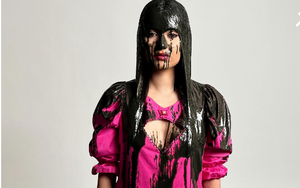Stella McCartney, H&M, Bestseller Make News At COP28
- by Sarah Mahoney @mahoney_sarah, December 7, 2023

Kianni's "We wear oil" campaign
It’s no accident that the 84,000 sustainability advocates gathered in Dubai are looking a little more glamorous. Fashion has taken the stage at COP28, the United Nations’ climate change conference.
Stella McCartney, the designer and brand known for blending high-fashion with innovative materials, is running a Sustainable Market exhibit at the conference, showcasing natural materials, including Stella McCartney x Veuve Clicquot accessories made from grape waste. (Conveniently, both brands are owned by luxury giant LVMH.)
The six vegan leather accessories that debuted during Paris Fashion Week are an example, pointing out the intense impact of animal agriculture on the environment. (It contributes to between 11% and 17% of greenhouse gasses.)
H&M and Bestseller, two global apparel giants, used the conference to announce an investment in an offshore wind power project in Bangladesh. With operations possibly beginning by 2028, it will provide a renewable energy source in a country is key to the textile industry.
advertisement
advertisement
And for the first time, the annual conference hosted a fashion show. The event’s organizers promised it wouldn’t “showcase the usual trash-to-fashion creations” -- but, instead, clothes wearable by and accessible to everyone.
Alarm and awareness about apparel's environmental impact keep growing, both within the industry and among consumers.
Textiles and garments are a significant source of water pollution and microplastics. And the industry’s steady violation of human rights is a significant issue, with low-skilled women around the world accounting for the majority of the workforce.
Meaningful change is proving elusive, even as sustainability advocates urge companies to step up their commitment to sustainable materials and energy, agreeing to phase out coal.
Two years ago, at COP26 in Glasgow, a number of brands signed the UN Fashion Charter for Climate Action, recommitting to meaningful steps to keep global heating below 1.5C. That promise called for cutting emissions in half by 2030.
While the brands that signed on should represent a high bar for other companies, a new report from Stand.earth shows that some signatories are moving backward.
Nine of the 14 fashion brands did report an overall decline in emissions from 2018 through the end of 2022. But if the current five-year trajectory holds, only four -- Levi’s, Kering, Ralph Lauren and Gap – will likely meet the end goal.
And alarmingly, 11 companies increased emissions between 2021 and 2022, including Chanel, Kering, LVMH, Ralph Lauren, Adidas, VF Corp., Lululemon, Puma, Fast Retailing, Gap and Inditex. Five of those reported a double-digit rise in emissions, including VF Corp. (19%), Lululemon (10%), Chanel (41%), LVMH (10%) and Ralph Lauren (13%).
Only H&M, Levi’s and Nike showed a reduction in emissions for the past two years
The Stand.earth report also called out company executives, including those at LVMH, for making misleading statements about their progress.
While consumers' demand for cleaner fashion choices has grown increasingly loud, recent Gen Z efforts are taking their objections to new levels. Despite the rise of brands like Shein and Temu, Gen Z-ers are turning up its nose at fast fashion and dialing up their commitment to thrifting and buying used. ThredUp estimates the resale market will reach $350 billion by 2027.
Climate advocate and influencer Sophia Kianna, for example, is working with Fossil Free Fashion via a “We wear oil” campaign. And Mock COP, drawing young people from more than 140 countries, is hard at work at the Dubai conference, uniting young people to urge countries to intensify climate action.


